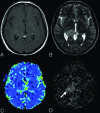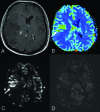Effects of Susceptibility Artifacts on Perfusion MRI in Patients with Primary Brain Tumor: A Comparison of Arterial Spin-Labeling versus DSC
- PMID: 31974077
- PMCID: PMC7015218
- DOI: 10.3174/ajnr.A6384
Effects of Susceptibility Artifacts on Perfusion MRI in Patients with Primary Brain Tumor: A Comparison of Arterial Spin-Labeling versus DSC
Abstract
Background and purpose: Our aim was to investigate the effects of intratumoral hemorrhage, calcification, and postoperative changes on the sensitivity of arterial spin-labeling and DSC perfusion MR imaging in patients with primary brain tumors.
Materials and methods: Eighty-six brain tumor lesions were examined with single-phase and multiphase arterial spin-labeling and DSC perfusion MR imaging. The lesions that had no intratumoral bleeding/calcifications and history of surgery were assigned to group 1 (n = 38), and the lesions that had these were assigned to group 2 (n = 48). The relative regional cerebral blood flow was calculated in both perfusion methods, and relative regional cerebral blood volume was calculated in DSC. Imaging results were correlated with histopathology or follow-up.
Results: In the quantitative evaluation, the sensitivity and specificity of relative regional cerebral blood flow in multiphase arterial spin-labeling perfusion were 94.4% and 80% in group 1 and 78.3% and 88% in group 2, respectively. The sensitivity and specificity of relative regional cerebral blood flow in DSC perfusion were 88.9% and 75% in group 1 and 78.3% and 84% in group 2, respectively. The sensitivity and specificity of relative regional cerebral blood volume in DSC perfusion were 66.7% and 100% in group 1 and 69.6% and 96% in group 2, respectively. In the qualitative evaluation, the sensitivities for single-phase and multiphase arterial spin-labeling were 48.2% and 79.3%, respectively, with 100% specificity for both.
Conclusions: The sensitivity and specificity of multiphase arterial spin-labeling were similar to those of DSC perfusion irrespective of bleeding and calcification in primary brain tumors. Thus, we suggest that noncontrast multiphase arterial spin-labeling can be used instead of DSC perfusion MR imaging in the diagnosis and follow-up of intracranial tumors.
© 2020 by American Journal of Neuroradiology.
Figures





Similar articles
-
Perfusion MR imaging of enhancing brain tumors: Comparison of arterial spin labeling technique with dynamic susceptibility contrast technique.Neurol India. 2017 Sep-Oct;65(5):1046-1052. doi: 10.4103/neuroindia.NI_871_16. Neurol India. 2017. PMID: 28879895
-
Comparison between dynamic susceptibility contrast magnetic resonance imaging and arterial spin labeling techniques in distinguishing malignant from benign brain tumors.Eur J Radiol. 2016 Sep;85(9):1545-53. doi: 10.1016/j.ejrad.2016.05.015. Epub 2016 Jun 6. Eur J Radiol. 2016. PMID: 27501887
-
Tumor recurrence versus treatment effects in glioma: A comparative study of three dimensional pseudo-continuous arterial spin labeling and dynamic susceptibility contrast imaging.Medicine (Baltimore). 2017 Dec;96(50):e9332. doi: 10.1097/MD.0000000000009332. Medicine (Baltimore). 2017. PMID: 29390403 Free PMC article.
-
Arterial spin-labeled MR perfusion imaging: clinical applications.Magn Reson Imaging Clin N Am. 2009 May;17(2):315-38. doi: 10.1016/j.mric.2009.01.008. Magn Reson Imaging Clin N Am. 2009. PMID: 19406361 Free PMC article. Review.
-
High-Resolution Neurovascular Imaging at 7T: Arterial Spin Labeling Perfusion, 4-Dimensional MR Angiography, and Black Blood MR Imaging.Magn Reson Imaging Clin N Am. 2021 Feb;29(1):53-65. doi: 10.1016/j.mric.2020.09.003. Epub 2020 Nov 2. Magn Reson Imaging Clin N Am. 2021. PMID: 33237015 Free PMC article. Review.
Cited by
-
Multidelay ASL of the pediatric brain.Br J Radiol. 2022 Jun 1;95(1134):20220034. doi: 10.1259/bjr.20220034. Epub 2022 May 12. Br J Radiol. 2022. PMID: 35451851 Free PMC article. Review.
-
Comparison of ASL and DSC perfusion methods in the evaluation of response to treatment in patients with a history of treatment for malignant brain tumor.BMC Med Imaging. 2024 Mar 22;24(1):70. doi: 10.1186/s12880-024-01249-w. BMC Med Imaging. 2024. PMID: 38519901 Free PMC article.
-
Hemodynamic property incorporated brain tumor segmentation by deep learning and density-based analysis of dynamic susceptibility contrast-enhanced magnetic resonance imaging (MRI).Quant Imaging Med Surg. 2024 Apr 3;14(4):2774-2787. doi: 10.21037/qims-23-1471. Epub 2024 Mar 28. Quant Imaging Med Surg. 2024. PMID: 38617153 Free PMC article.
-
Current state and guidance on arterial spin labeling perfusion MRI in clinical neuroimaging.Magn Reson Med. 2023 May;89(5):2024-2047. doi: 10.1002/mrm.29572. Epub 2023 Jan 25. Magn Reson Med. 2023. PMID: 36695294 Free PMC article.
-
[Consistency analysis between 3D arterial spin labeling and dynamic susceptibility contrast perfusion magnetic resonance imaging in perfusion imaging of brain tumor].Nan Fang Yi Ke Da Xue Xue Bao. 2021 Aug 20;41(8):1283-1286. doi: 10.12122/j.issn.1673-4254.2021.08.23. Nan Fang Yi Ke Da Xue Xue Bao. 2021. PMID: 34549723 Free PMC article. Chinese.
References
Publication types
MeSH terms
Substances
LinkOut - more resources
Full Text Sources
Medical
